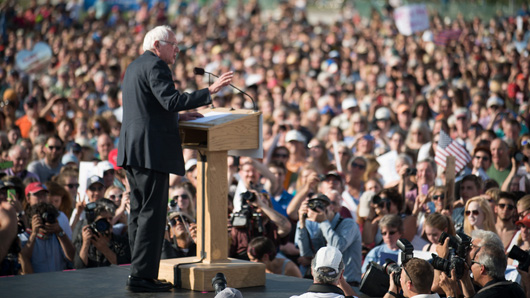
Billionaires for Bernie? Well, if you believe what the Wall Street wonks over at Third Way are saying about Sanders’ plan to expand Social Security, you might think that the billionaire class should get their checkbooks ready and start writing out donation checks to his campaign. If what they are claiming is true, then contrary to everything you might have heard about him, Bernie the socialist is really just a stalking horse for the super-rich.
In a report just released, the finance-sector-funded right-wing Democratic think-tank declared that Sanders’ Social Security Expansion Act (S. 731), despite the supposedly progressive credentials of its sponsor, is actually just a program for redistributing more wealth to those who already have a lot of it.
Really?
So this whole “political revolution” thing is all a fraud? What about the much-vaunted “democratic socialism” and the $27 average campaign contributions? Just covers for the same old bought-and-paid-for establishment politics?
That is the story that Third Way is trying to peddle, but you don’t have to look very deep into their claims to find out there’s really not much there. What Sanders has actually proposed is nothing less than a massive expansion of Social Security benefits for all, backed by a tax plan that asks the wealthiest to finally pay their fair share of Social Security taxes – the same taxes that working class Americans have been paying for decades.
So how does Third Way manage to twist a progressive proposal like this into a trickle-up scheme for the wealthy?
Third Way’s claims and Sanders’ true aims
Utilizing a whole set of slick graphics and a list of major citations, authors Jim Kessler and David Brown authoritatively make the claim that the new benefits Sanders proposes for America’s seniors “are substantially tilted toward the wealthy, spending five times more on the wealthy than on the poor.”
Going even further, they accuse Sanders of selling out the young in order to boost payouts to the richest senior citizens. According to them, Sanders denies “progressive priorities for children and younger generations.” Presenting a stark choice, they say that if the country goes along with Sanders’ Social Security expansion, then there will be no money left for pre-K programs, community college, child care, and the rest.
Putting forward such talking points now, it is clear that Third Way is out to shape the political narrative as the early primary states head to the polls and the Sanders campaign appears to be hitting its stride. Their audience is not the voting public, however. They are not trying to sway activists and campaign volunteers. This is not a grassroots or movement-oriented organization.
Rather, Third Way’s product is targeted toward policy elites and the talking-head media crowd. If they can successfully influence what is said on the television news programs and on the newspaper editorial pages, then they think they can shape public opinion from the top and undermine Sanders’ credibility.
Contrary to Third Way’s claims, the Sanders plan for Social Security is actually built around an across-the-board benefit increase for every recipient. As a percentage of earnings, those at the lowest end of the spectrum would get the biggest boost to their payout. The minimum benefit would also be raised, guaranteeing that those who spent a lifetime in low-wage jobs will not be forced to live in poverty when they are older. And finally, it would adopt a cost-of-living-adjustment (COLA) schedule that is tied to inflation. This would ensure that seniors’ benefits don’t lose value over time as prices rise.
To cover these program expansions and keep Social Security solvent in the long-term, Sanders’ proposes new taxes – but only on those whose incomes are over $250,000. He would lift the cap on the Social Security payroll tax. Right now, all workers earning under $250,000 pay more taxes as a proportion of their income than do those earning above it. The cap is inherently regressive. The Sanders plan would remove it, meaning high-earners would finally have to pay the same tax as everyone else.
This is the centerpiece of Sanders’ funding plan, yet Third Way only barely mentions it. They stuff it into the appendix at the end of the report! If this was a serious analysis and critique of the Sanders’ plan, the Social Security tax cap would be featured center stage. The fact that it is not exposes the Third Way report and all of its claims as nothing more than a political hit piece – not the objective analysis it purports to be.
Not quite a lie, but definitely not the truth
In order to make its claims, Third Way resorts to some pretty disingenuous interpretations and gets a little loose with facts. They truthfully assert, for instance, that under the Sanders plan, “the top income quintile of seniors receives nearly as much in new Social Security benefits as the bottom two quintiles combined.” What they don’t make clear is that the top quintile starts at $63,000 per year. That means that the bottom 80% of Social Security recipients have incomes below that amount.
By just referring to “quintiles” without clearly defining what income brackets they include, the report leads readers to believe that Sanders is delivering big money to the top 20%. It is true that those earning over $63,000 will see larger absolute dollar increases than those in the lower 40%. But by the same token, as a percentage of their income, those in the lower income brackets will actually see the biggest increases. Third Way’s report would have you believe the exact opposite.
Lest you start to think of them as a crusader for the poor, Third Way’s goal when it comes to Social Security is not to look out for our lowest-income seniors and disabled. Don’t forget, this is the same group that led the fight for a chained CPI (Consumer Price Index) for calculating benefit rates rather than inflation-adjusted COLA’s, effectively amounting to annual cuts. They are the ones who were pushing for a “Grand Bargain” with Republicans during the “Fiscal Cliff” negotiations that would have seen permanent cutbacks to Social Security. The same outfit whose president, Jon Cowan, has been trying since as far back as 1995 to divide seniors and young workers so that Wall Street can move up the middle and privatize Social Security.
Sinking to the level of claiming that Bernie Sanders, of all people, is a tool of the rich signals that some in the camp of the Wall Street Dems are running scared. Just this week, Lloyd Blankfein said the Sanders candidacy represented a “dangerous moment.” He’s the CEO of Goldman Sachs, which gave Third Way $850,000 over the period 2010-11, at the height of the fight for tougher banking regulations.
At the core of Third Way’s political practice has always been the idea that the rich already pay too much in taxes, so we’ve got to stop asking them to pony up more cash. Our political system, they say, just “does not have the appetite to pass this enormous tax increase and come up with another tax increase to pay for domestic priorities.” So the nation has to choose. We can’t have it all – Social Security, Medicare, good jobs, and education. It’s the same austerity message they’ve been peddling for years.
But with the popularity of Sanders’ campaign and its anti-Wall Street message, they can no longer just rely on their well-worn tropes of fiscal irresponsibility or denouncing the left as radical and unrealistic. A lot of folks just don’t buy it anymore.
Considering that Third Way has long been on record as favoring cuts to Social Security benefits, it’s more than just a little absurd that they would now be presenting themselves as the defenders of the program against a Bernie Sanders supposedly out to rob from the poor and give to the rich.
It just isn’t believable.
And that’s because it just isn’t true.
Photo: AP










